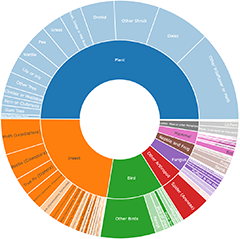Spiders
Spiders
Tips for submitting spider sightings:
Photos from various angles are sometimes necessary for specific ID.
- front (eye arrangement, pedipalp colour)
- dorsal (above - general colouration, carapace and abdomen patterns)
- ventral (underneath - especially useful for some of the ground-dwelling families and orb-weaving families)
- side (further details for general shape, abdomen patterns and eye configuration)
- back (further details for abdomen pattern).
Comments or photos on the following also provides valuable information if/when such features are applicable and observed...
- surroundings and location (eg. ground, leaf litter, hand rail, tree trunk)
- web structure and silk use (eg. orb, messy & tangled, throwing silk)
- breeding (eg. display, egg sac)
- behaviour (eg. hunting, interaction, familiarity with people such as the threatening display of a huntsman or the friendly and curious jumping spiders that jump onto the camera lens)
- notable, unique, exciting or strange observations (eg. spur-like protrusions from legs, camouflage, mimicry)
Please note that the size of the spider is measured by body length.
- body size is from the top of the cephalothorax (head) to the tip of the abdomen without including the legs.
(Updated: October, 2022. Please feel free to message a spider moderator if you have any queries or suggestions for improvement)
Resources:
- Field guide: A Field Guide to Spiders of Australia authored by Robert Whyte & Greg Anderson
- A good introduction: http://www.ento.csiro.au/education/allies/araneae.html
- All about Australian spiders: http://www.arachne.org.au/01_cms/details.asp?ID=2409
Announcements
There are currently no announcements.
Discussion
NateKingsford
wrote:
14 Nov 2025
Hey @MMhoneybee, this one doesn't have any photos either
Unverified Jumping or peacock spider (Salticidae)
NateKingsford
wrote:
14 Nov 2025
Hey @MMhoneybee, there doesn't appear to be any photos for this sighting, could you please double check :)
Unverified Jumping or peacock spider (Salticidae)
NateKingsford
wrote:
13 Nov 2025
Not a funnel web, Stanwellia are mildly venomous and pretty common in Victoria
Stanwellia sp. (genus)
Significant sightings
- Maratus mungaich at Pickering Brook, WA
- Idiosoma sp. (Genus) at Denman Prospect, ACT
- Maratus robinsoni at Oallen, NSW
- Maratus hesperus at Uriarra Village, ACT
- Acroaspis olorina at Mount Ainslie to Black Mountain
- Myrmarachne (genus) at Sea Acres National Park
- Anamidae at Kenny, ACT
- Maratus harrisi at Kosciuszko National Park
- Maratus harrisi at Yaouk, NSW
- Maratus hesperus at Yaouk, NSW
Top contributors
- Hejor1 2.6K
- AlisonMilton 1.1K
- TimL 863
- trevorpreston 809
- CathB 681
- Harrisi 432
- ConBoekel 426
- kasiaaus 356
- WendyEM 263
- Christine 260
Top moderators
- MichaelMulvaney 8.1K
- NateKingsford 1.7K
- YumiCallaway 1.5K
- KimPullen 969
- EmmaCollins 779
- EathanDouglas 431
- MichaelBedingfield 301
- Bron 168
- Harrisi 119
- NedJohnston 53














































































































